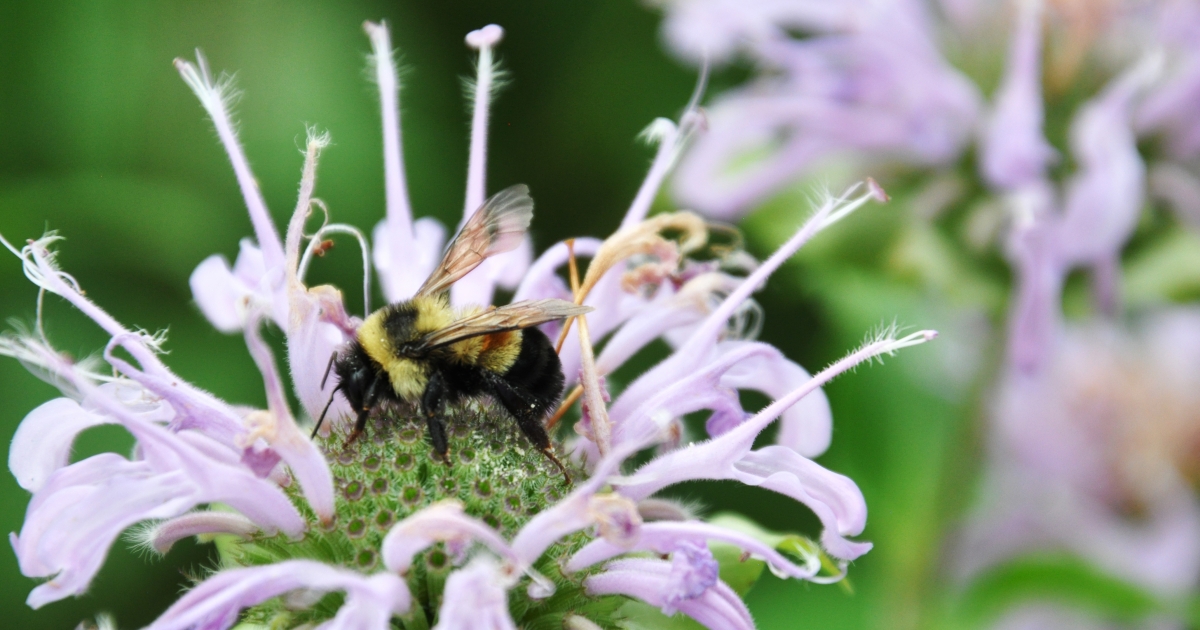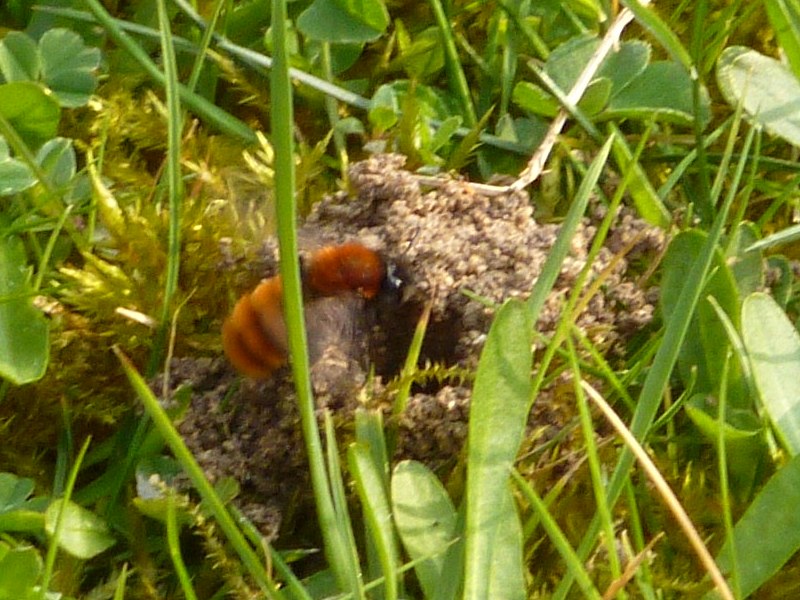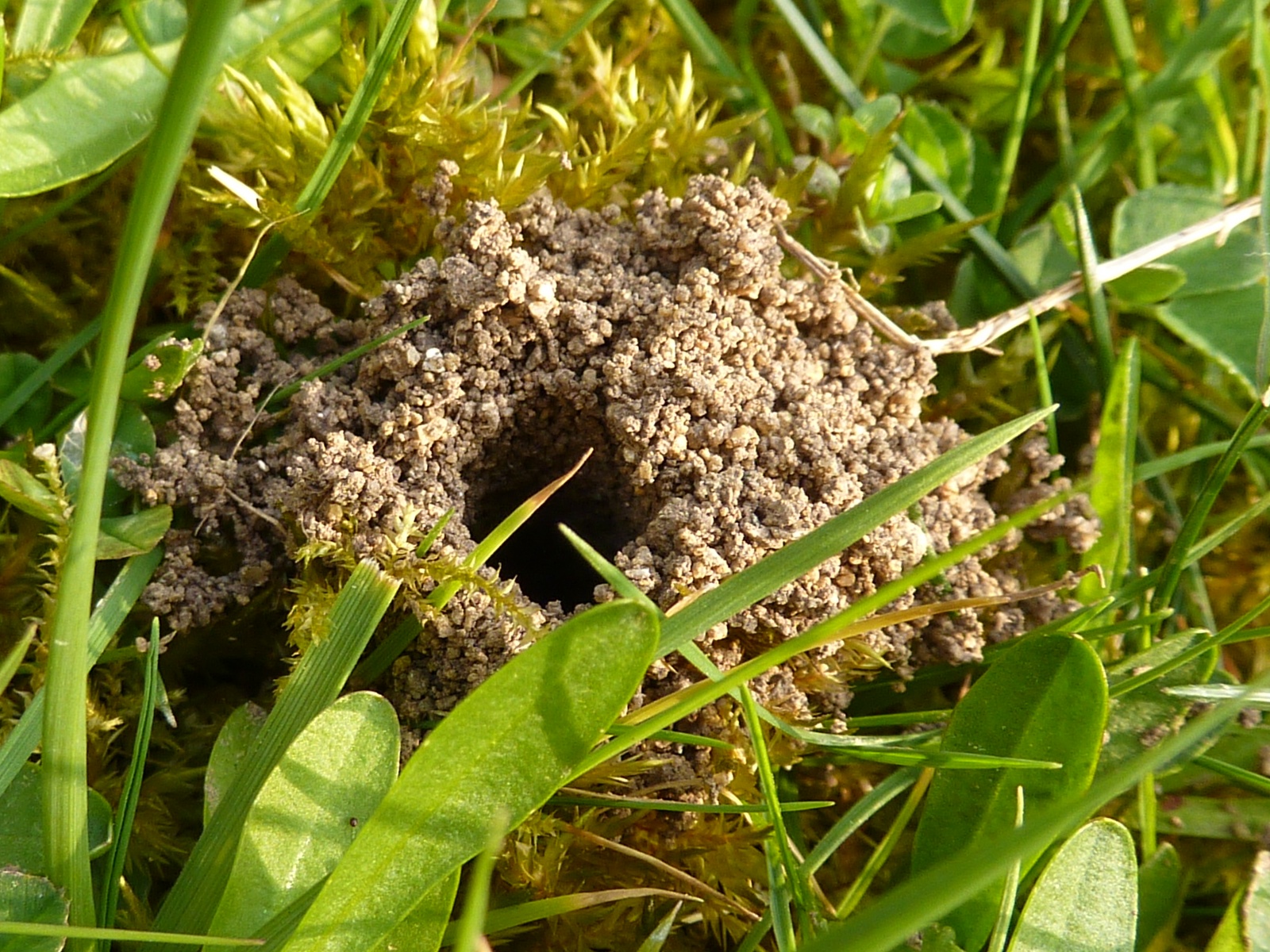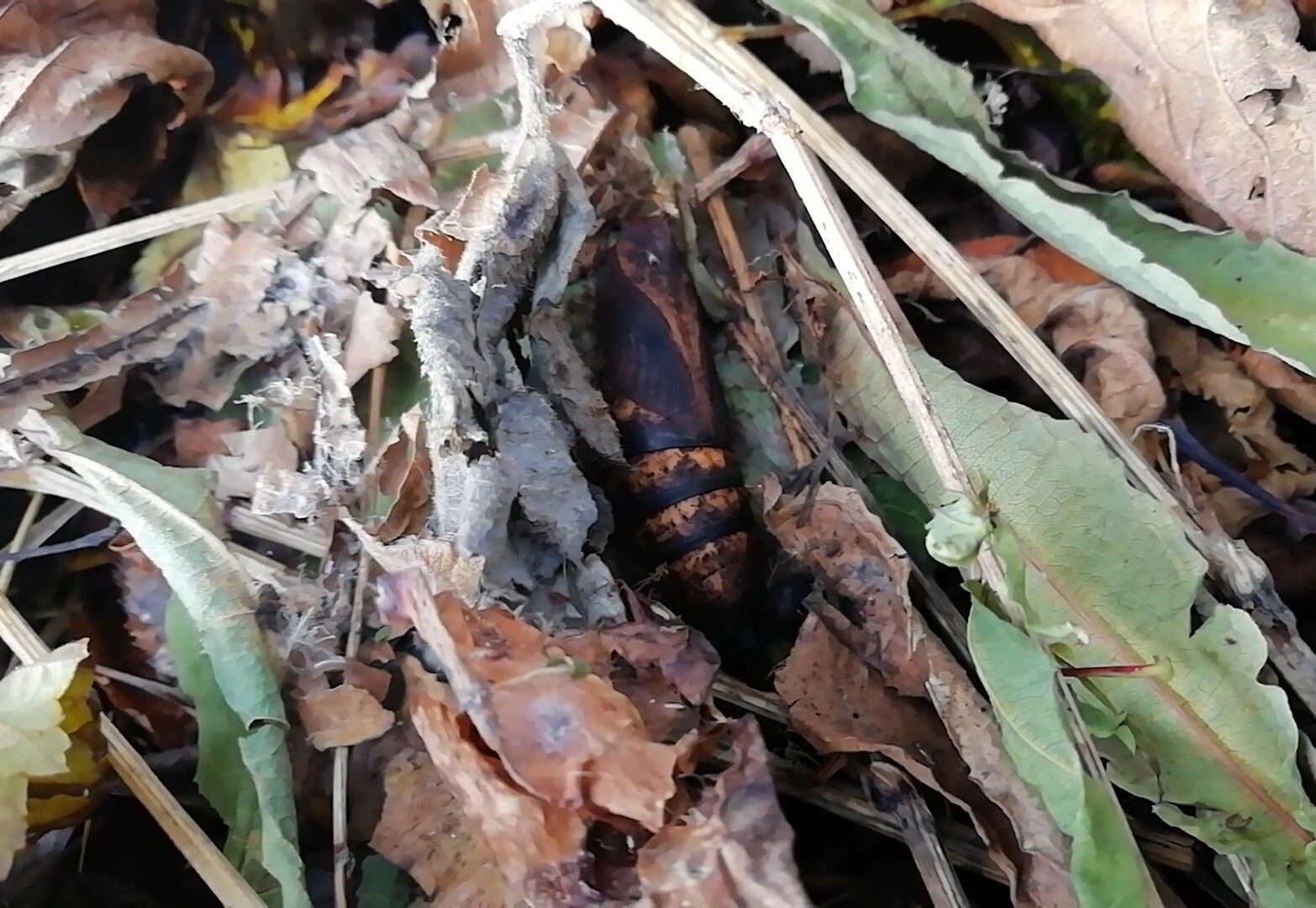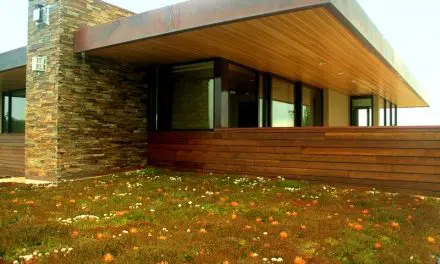The rusty patched bumble bee is one of about 21 species of bumble bees in the eastern United States, and was listed as federally endangered in 2017. Species of Bombus typically nest in soft soil, a few centimeters deep. Photo Rusty patched bumblebee, Jill Utrup/USFWS, Public Domain.
Pollinator gardening means less raking
By Allie Rigby
Two hundred years ago, was the area you live covered with trees? Then healthy soil includes a healthy amount of leaf litter. If you aim for an eco-friendly yard and garden, there are excellent reasons to leave your leaves. Let your leaf litter accumulate each fall and well into spring.
In autumn, leaves carpet the forest floor. Leaf litter and brush provide ample food sources and habitat for birds and insects. And the microorganisms within help plants to thrive. Tiny organisms on insects themselves keep them healthy, which benefits birds and other animals up the food chain.
By spring, the leaves have dried, molded, decomposed, and been repurposed again and again. They’ve become nesting material, hiding places, and food. Leaving the seedheads and stalks of perennial plants provides food for birds. (And it’s nice to see the wildlife over the winter.) The stems and stalks left standing give the native bees shelter for hibernation through the winter.
Look at your lawn, backyard pollinator garden, decorative plants, or fruit trees. All kinds of organisms, including pollinators, can benefit from even just a few scattered leaf piles in your yard. A native pollinator garden design benefits us all.
Raked leaves collected in bags produce methane
In general, keeping organic matter out of landfills is the greener option. Avoid raking it up, tying it in a plastic bag, and throwing it in a landfill. More than 7% of material in US landfills comes from yard trimmings, increasing up to 50% during peak months of the summer.
In landfills, yard trimmings–including leaves–do not decompose as well. In gardens, flourishing populations of microorganisms help break them down. And leaves release more methane when they are not returned to the soil. Methane is a worse greenhouse gas than carbon dioxide.
Instead of going to landfills, imagine if leaf litter did what it does in a forest ecosystem:
- Keeps root systems moist
- Suppresses weeds
- Houses bees, butterflies, and other pollinators
- Promotes soil health
- Supports biodiversity
Tawny Mining Bees (native to the UK) nest individually and are harmless, leaving their offspring to overwinter underground. They are useful spring pollinators of fruit trees and bushes. “Tawny Mining Bee(f) – Andrena Fulva 2b – Returning to nest” and “Tawny Mining Bee(f) – Andrena Fulva 2d – Returning to nest” images by Dluogs licensed under CC BY-SA 2.0 DEED
Who benefits from leaf litter?
Most animal life on the planet are invertebrates (animals without backbones). Insects are the largest class of invertebrates, by number of species, and include moths, caterpillars, beetles, bees, and more.
Butterflies and moths decreased by 50% in areas of lawns where leaf litter was removed each fall. And note that shredding leaves or using them as mulch does not help the insect populations. Likely because it’s still majorly disruptive to critters living in the litter.
One obstacle to making leaf litter more “popular” is awareness. And in part, it’s aesthetics. Publications, TV shows, and other media tend to showcase broad green lawns and tidy gardens.
But there are many environmental problems with traditional grass yards. And pollinator yards, even a front yard pollinator garden, can be lovely and practical. And there’s nothing inherently undesirable or “ugly” about leaves.
It may be inconvenient to have leaves on your main walkways, creating slippery hazards. But what about leaving a few areas in your hard for leaves to accumulate?
It’s a cultural preference here in the US to rake leaves. Mostly to preserve extravagant grass lawns. Many Homeowners Associations (HOAs), for example, require raking. Without outside requirements, you can consider using native plants, perennials, and leaf litter for your garden to attract pollinators.
Planting a pollinator garden? Don’t waste it!
Insects in your yard help pollinate flowers, including fruits and vegetables. In spring, they’re overwintering or hiding in chrysalises in leaf piles that have been decomposing since fall. That is why, if you must rake, try to wait until as late into spring as possible. Give those insects time to metamorphose, hatch, and fly to their food plants.
Balanced gardens have healthy populations of pollinators that keep flowering plants propagating. Butterflies pollinate perennials like milkweed and coneflowers, while bees are vital for berries, tomatoes, and squash. That’s why every pollinator-friendly garden needs cover.
Humans also benefit from leaf litter and pollinator gardening. We need insects for the delicious produce the Earth provides.
Beautiful elephant hawk-moths (also native to the UK) overwinter in fragile cocoons at the base of plants in loose plant debris and leaf litter. “Small elephant Hawk-moth” image © Natural England/Allan Drewitt 17 May 2014 is licensed under CC BY-NC-ND 2.0 DEED. Cocoon image courtesy ButterflyConservation.org.
Shhh! Bumble bee queens hibernating, along with other pollinators
Many hymenoptera overwinter in and under fallen leaves, including bees, wasps, and bumblebees. For bumblebees—those larger, fuzzier bees—their queens burrow under leaf piles to hibernate. That’s why researchers and conservationists advocate to “Leave the Leaves” between fall and spring, so that bees, butterflies, moths, flies, and beetles can emerge, reproduce, and continue pollinating so many key plant species in our gardens.
It’s worth noting that the relationship among hymenoptera and other families of insects, especially invasive species, is complex. Imported species carry diseases and parasites that decimate native populations. And paper wasps hunt and kill some key pollinators, such as monarchs. Most paper wasps don’t hibernate in the leaves though. So again – leave those leaves!
Not all native bees require leaf litter, but many do require undisturbed nesting areas. Be careful and avoid digging near any observed nesting sites, which look like small ant hills.
Designing a garden with native plants
There’s a growing movement to create gardens with greater biological systems in mind. You can do this by designing with swales, creating welcoming habitat for birds, and considering pollinator garden designs.
Planting native flowers and shrubs that thrive in your region is easy and inexpensive. Especially if you live in an area with frequent droughts, you can save money on irrigation . Visit your local nursery for inspiration and advice, or research what it takes to become a National Wildlife Habitat.
Remember that perfection is not the goal, so never say “never rake again.” Instead, think of small steps you can take. Is there a patch of lawn that you can leave covered in leaves year-round? Less raking is still better than frequent raking.
If you’re worried about what the neighbors think, consider adding a hand-painted sign. “Leaf Litter Zone” or Pollinator Garden” will help spread the word on what you’re doing and why it matters.
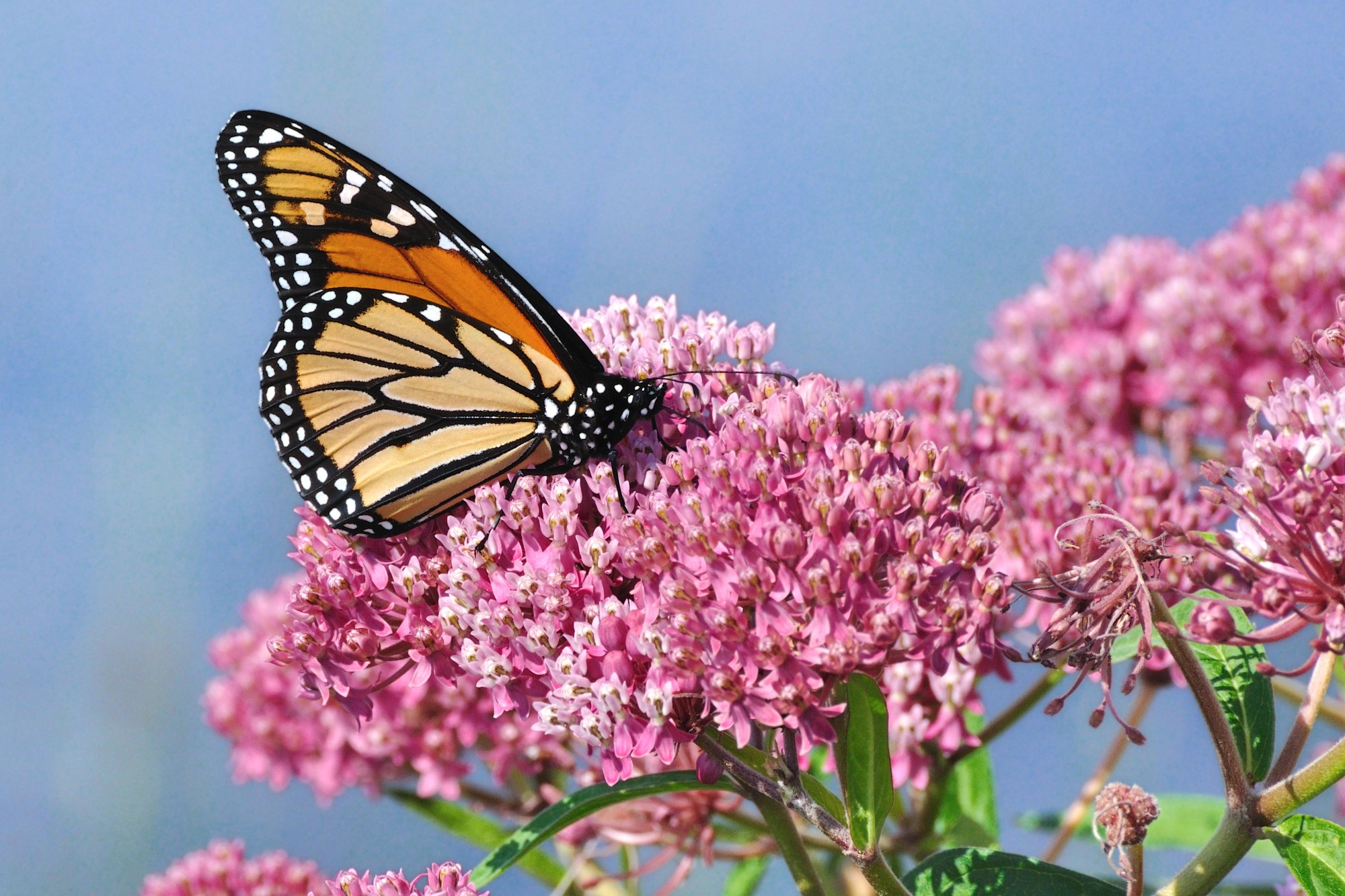
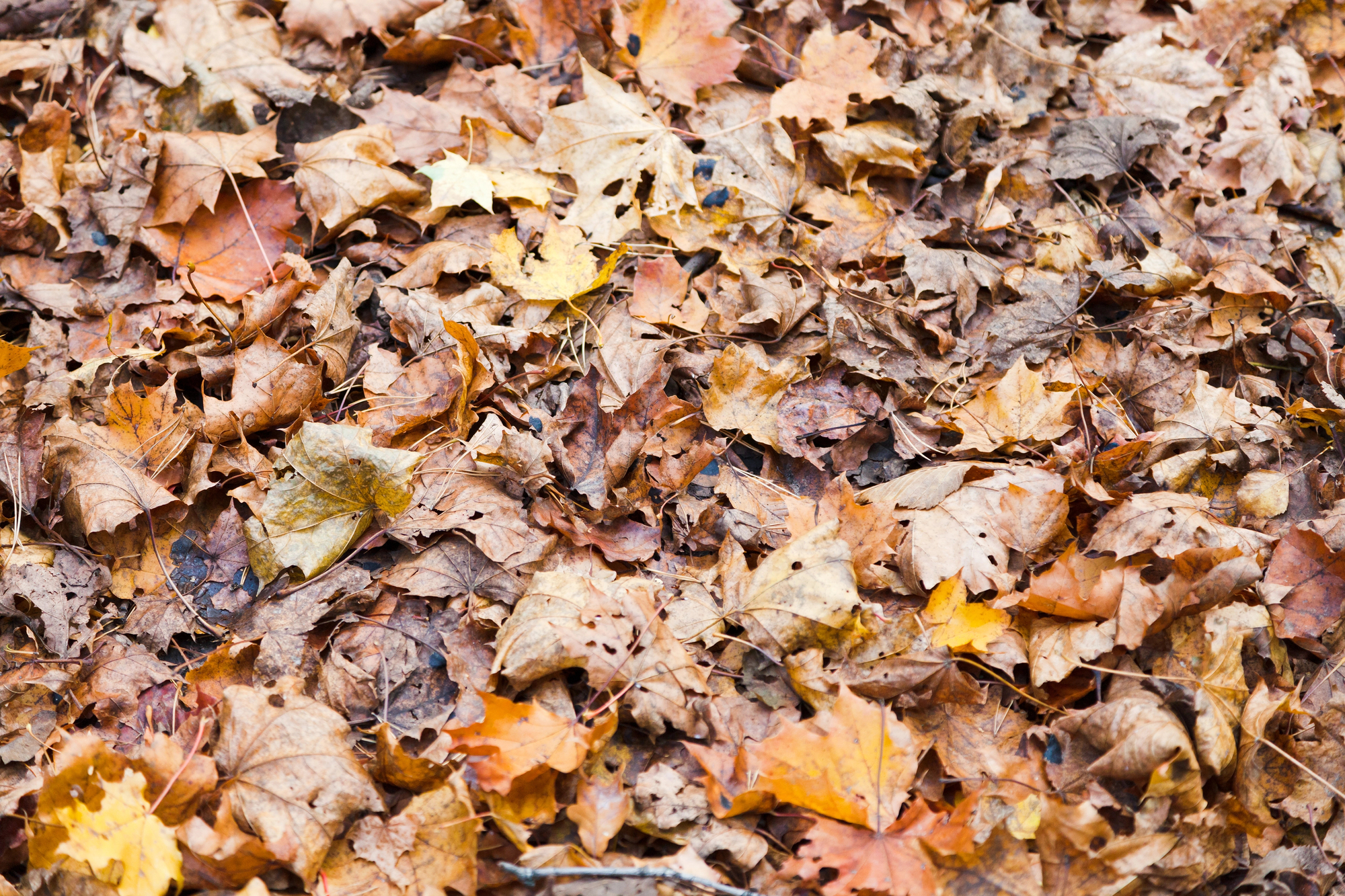
Consider the little guys: Leave your leaves
Spring and fall are both vital times to remember that invertebrates and microorganisms make our lives better as humans. After all, we couldn’t eat without their hard work. Keep them in mind in your landscape planning, lawn care, and gardening.
About the author:
Allie Rigby has a master’s in creative writing and a bachelor’s in environmental analysis. With Sunlight Editing, she creates educational content with the aim of inspiring people to enact local, positive change.
Our team researches products, companies, studies, and techniques to bring the best of green building to you. Elemental Green does not independently verify the accuracy of all claims regarding featured products, manufacturers, or linked articles. Additionally, product and brand mentions on Elemental Green do not imply endorsement or sponsorship unless specified otherwise.


